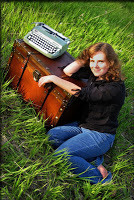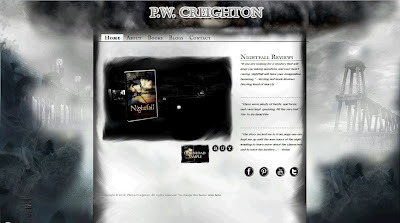P.W. Creighton's Blog, page 8
September 10, 2012
Paranormal Perceptions ~ Folklore and Myth as Inspiration
This post is to be the first of a new series called Paranormal Perceptions.
The Paranormal Perceptions series was created to gather some of the most interesting authors that are using paranormal elements in their stories. Every author has their own perceptions and provides their own insight on all things paranormal, ranging from urban legends and paranormal research, to myths and inspirations. This week on the guest series is author of Dark Light of Day author Jill Archer (@archer_jill)
[image error]Using Folklore and Myth as Inspiration for Your Story
There's been a resurgence of the use of folktales and myths as story inspiration these days. Consider these examples of recent television shows, movies, and novels:
Once Upon A Time: ABC's show based, in part, on fairy tales previously depicted by Disney
Grimm: NBC's grittier show containing characters inspired by Grimms' Fairy Tales
Mirror Mirror: Movie retelling of Snow White tale from step-mother's perspective
Thor: Movie based on the superhero inspired by Norse mythology
Abandon by Meg Cabot: Novel telling the "myth of Persephone... darkly reimagined"
Cinder by Marissa Meyer: Novel about a cyborg mechanic caught in a forbidden attraction
Not to mention what's in the pipeline (thanks to ashley_angel, who created the IMDb list [http://www.imdb.com/list/7dmNumkftqQ/] I pulled these from):
Hansel and Gretel: Witch Hunters -- 2013, starring Jeremy Renner
Maleficent -- 2014, starring Angelina Jolie
Pinocchio -- 2014, starring Danielle Radcliff (voice)
Arabian Nights -- 2014, starring Liam Hemsworth
As readers and watchers, it's easy to appreciate the timeless appeal of these stories. But, as novelists, how do we turn old fairy tales and ancient myths into successful stories for today's audiences?
Be cautious of a saturated market. Make sure you're using your inspirational sources for the right reasons. Grabbing an old archetype or well-worn character in the hopes you can quickly shine it up and offer it for a sale will likely result in creative disappointment and financial frustration.
Consider using lesser known characters or myths. Everyone's heard of Cinderella, Snow White, Hansel and Gretel. But who's heard of The Old Woman in the Wood? Or The Seven Ravens? Or Jorinda and Joringel? Those are also fairy tales from the Brothers Grimm, but they haven't been strip mined like the others. (Thanks to The Fairy Tale Cupboard for the suggestions: http://thefairytalecupboard.blogspot....).
Use ancient tales and characters only as a spring board. And then jump high and far. For my debut novel, Dark Light of Day, I drew character inspirations from myriad sources: Biblical mythology, Jewish folklore, Celtic fertility goddesses, Egyptian war gods, Babylonian deities, and Greek demons -- just to name a few. Because the book isn't a reimagining, I had even more freedom to pick and choose which traits of the original inspirational sources I wanted my characters to have. Sparking creativity was the primary goal of my research, as opposed to ensuring I was accurately interpreting the myths I used.
Keep in mind, there's likely an element of truth to every folktale, myth, legend, or fairy tale. Speaking of inspiration, where do you think the inspirations for the folktales themselves came from? At some point in the distant past -- before those stories became archetypal -- their inspirations may have been something that really happened. (The legend of Count Dracula was inspired by Vlad Tepes, the 15th century Eastern European prince). Other myths are probably man's early attempt to explain something they didn't fully understand. (Persephone is the personification of the earth's birth, death, and re-birth cycle during its changing seasons). And many fairy tales were likely designed to warn children about real dangers. (Talking to strangers is dangerous, whether you're wearing a red cloak or not). Knowing folklore's purpose, and the reasons for its popularity, will help you to use it more effectively in your own writing.
Want to hear another author talk about she used ancient folklore to inspire her story? Check out this recent post by Lucy Wood, author of Diving Belles here.
Writers, have you used folktales and myths as inspiration for your stories? If so, which ones? How did you go about it? Was your story a reimagining of an original tale? Or did you use mythological characters and settings to create bits and pieces of an entirely new story?
Readers, do you like stories inspired by folktales and myths? If so, what are some of your favorites? Thank you, Phillip, for hosting me here at The Surveillance Report!
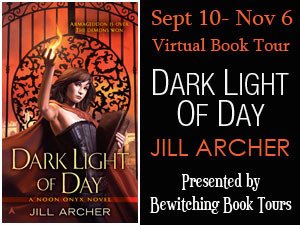
Dark Light of Day
Armageddon is over. The demons won. And yet somehow…the world has continued. Survivors worship patron demons under a draconian system of tributes and rules. These laws keep the demons from warring among themselves, the world from slipping back into chaos.
Noon Onyx grew up on the banks of the river Lethe, daughter of a prominent politician, and a descendant of Lucifer’s warlords. Noon has a secret—she was born with waning magic, the dark, destructive, fiery power that is used to control demons and maintain the delicate peace among them. But a woman with waning magic is unheard of and some will consider her an abomination.
Noon is summoned to attend St. Lucifer’s, a school of demon law. She must decide whether to declare her powers there…or attempt to continue hiding them, knowing the price for doing so may be death. And once she meets the forbiddingly powerful Ari Carmine—who suspects Noon is harboring magic as deadly as his own—Noon realizes there may be more at stake than just her life.
Jill Archer writes urban fantasy novels and other fun and/or creepy stuff. Her first novel, DARK LIGHT OF DAY, is being released on September 25, 2012 by Penguin/Ace. Jill lives in rural Maryland with her two children and husband, who is a recreational pilot. Weekends are often spent flying around in the family's small Cessna, visiting tiny un-towered airfields and other local points of interest.
Website: www.jillarcher.com
Twitter: @archer_jill
September 7, 2012
Paranormal Perceptions: The World of the Paranormal
This post is to be the first of a new series called Paranormal Perceptions.
The Paranormal Perceptions series was created to gather some of the most interesting authors that are using paranormal elements in their stories. Every author has their own perceptions and provides their own insight on all things paranormal, ranging from urban legends and paranormal research, to myths and inspirations. This week on the guest series is author of Wolf's Maine author Jinni James (@jinnijames)
 Who doesn’t love Paranormal Romance?
Who doesn’t love Paranormal Romance?
I chose to write about Paranormal Romance because I feel a lot of people just love it. I mean it is the unknown, the fantasy. Everyone loves the fantasy right?
I did a lot of research on the internet about shape shifters, werewolves, and vampires but all in all I just wrote about how I wanted each of my characters. I took in what I read online and incorporated it into my story. I kind of mixed in the paranormal world within our world instead of creating a different world all together. I think it makes it a little more relatable.
My influences for my story come from many different places. Since I based this story from real life every character and everything that happens is in some way relatable to me. I did decide to make the vampire the bad guy in my story. I have read a lot of books lately where the vampire is the good guy, the one the heroine falls in love with but I decided to change it up and make the vampire the bad guy and the shape shifter the one that gets the girl. I have not read many books like that yet but I do hope to find some.
Don’t get me wrong I love vampires just as much as the next girl but I wanted a change for my characters. I loved getting lost in the forbidden world of Paranormal Romance and I think that is why a lot of people love to read it. It is so different from our everyday lives. Plus, I am sure a lot of women love to fantasize that there is a world like this out there somewhere. I loved writing about the Paranormal and I look forward to writing many more.
Avalon felt like her life was set on repeat. Every new day was just like the one before until Avalon's friends talk her into venturing out and leaving her dead end
marriage behind. Little did she know that she would meet her soul mate face to face and that he would ignite a desire in her that she never knew existed. John had been watching over Avalon ever since her parents died when she was three but she
had no clue.
She had only been talking to him online for two years. She slowly learns that there is a whole world and a whole story she had not known about involving every one she knows and cares for. Her husband Nicholas is not the man she thought him to be, if he is a man at all and John seems to be more than he lets on as well.
Avalon soon discovers the hidden truths but can she handle it? With Nicholas seeking vengeance can John and her friends help her?
Jinni James is an administrative assistant, wife, and mother of two girls as well as a step mother based in Huntsville, Alabama. Since child hood she has written many short stories and poems but never dreamed of writing a novel. She attempted to write many stories but never finished. Finally she was in the perfect place in her life to write a story that had been invading her thoughts and dreams for a very
long time. That story blossomed into her first novel The Wolfs Maine. She is now currently working on her next novel.
Connect with Jinni:
http://authorjinnijames.blogspot.com
http://www.facebook.com/jinnijames
http://www.goodreads.com/author/show/6471779.Jinni_James
Giveaway ~ Jinni is offering one ebook and a signed print book to two lucky commenters.
September 5, 2012
Paranormal Perceptions ~ Folklore and Myth as Inspiration
This post is to be the first of a new series called Paranormal Perceptions.
The Paranormal Perceptions series was created to gather some of the most interesting authors that are using paranormal elements in their stories. Every author has their own perceptions and provides their own insight on all things paranormal, ranging from urban legends and paranormal research, to myths and inspirations. This week on the guest series is author of Dark Light of Day author Jill Archer (@archer_jill)
[image error]Using Folklore and Myth as Inspiration for Your Story
There's been a resurgence of the use of folktales and myths as story inspiration these days. Consider these examples of recent television shows, movies, and novels:
Once Upon A Time: ABC's show based, in part, on fairy tales previously depicted by Disney
Grimm: NBC's grittier show containing characters inspired by Grimms' Fairy Tales
Mirror Mirror: Movie retelling of Snow White tale from step-mother's perspective
Thor: Movie based on the superhero inspired by Norse mythology
Abandon by Meg Cabot: Novel telling the "myth of Persephone... darkly reimagined"
Cinder by Marissa Meyer: Novel about a cyborg mechanic caught in a forbidden attraction
Not to mention what's in the pipeline (thanks to ashley_angel, who created the IMDb list [http://www.imdb.com/list/7dmNumkftqQ/] I pulled these from):
Hansel and Gretel: Witch Hunters -- 2013, starring Jeremy Renner
Maleficent -- 2014, starring Angelina Jolie
Pinocchio -- 2014, starring Danielle Radcliff (voice)
Arabian Nights -- 2014, starring Liam Hemsworth
As readers and watchers, it's easy to appreciate the timeless appeal of these stories. But, as novelists, how do we turn old fairy tales and ancient myths into successful stories for today's audiences?
Be cautious of a saturated market. Make sure you're using your inspirational sources for the right reasons. Grabbing an old archetype or well-worn character in the hopes you can quickly shine it up and offer it for a sale will likely result in creative disappointment and financial frustration.
Consider using lesser known characters or myths. Everyone's heard of Cinderella, Snow White, Hansel and Gretel. But who's heard of The Old Woman in the Wood? Or The Seven Ravens? Or Jorinda and Joringel? Those are also fairy tales from the Brothers Grimm, but they haven't been strip mined like the others. (Thanks to The Fairy Tale Cupboard for the suggestions: http://thefairytalecupboard.blogspot....).
Use ancient tales and characters only as a spring board. And then jump high and far. For my debut novel, Dark Light of Day, I drew character inspirations from myriad sources: Biblical mythology, Jewish folklore, Celtic fertility goddesses, Egyptian war gods, Babylonian deities, and Greek demons -- just to name a few. Because the book isn't a reimagining, I had even more freedom to pick and choose which traits of the original inspirational sources I wanted my characters to have. Sparking creativity was the primary goal of my research, as opposed to ensuring I was accurately interpreting the myths I used.
Keep in mind, there's likely an element of truth to every folktale, myth, legend, or fairy tale. Speaking of inspiration, where do you think the inspirations for the folktales themselves came from? At some point in the distant past -- before those stories became archetypal -- their inspirations may have been something that really happened. (The legend of Count Dracula was inspired by Vlad Tepes, the 15th century Eastern European prince). Other myths are probably man's early attempt to explain something they didn't fully understand. (Persephone is the personification of the earth's birth, death, and re-birth cycle during its changing seasons). And many fairy tales were likely designed to warn children about real dangers. (Talking to strangers is dangerous, whether you're wearing a red cloak or not). Knowing folklore's purpose, and the reasons for its popularity, will help you to use it more effectively in your own writing.
Want to hear another author talk about she used ancient folklore to inspire her story? Check out this recent post by Lucy Wood, author of Diving Belles here.
Writers, have you used folktales and myths as inspiration for your stories? If so, which ones? How did you go about it? Was your story a reimagining of an original tale? Or did you use mythological characters and settings to create bits and pieces of an entirely new story?
Readers, do you like stories inspired by folktales and myths? If so, what are some of your favorites? Thank you, Phillip, for hosting me here at The Surveillance Report!

Dark Light of Day
Armageddon is over. The demons won. And yet somehow…the world has continued. Survivors worship patron demons under a draconian system of tributes and rules. These laws keep the demons from warring among themselves, the world from slipping back into chaos.
Noon Onyx grew up on the banks of the river Lethe, daughter of a prominent politician, and a descendant of Lucifer’s warlords. Noon has a secret—she was born with waning magic, the dark, destructive, fiery power that is used to control demons and maintain the delicate peace among them. But a woman with waning magic is unheard of and some will consider her an abomination.
Noon is summoned to attend St. Lucifer’s, a school of demon law. She must decide whether to declare her powers there…or attempt to continue hiding them, knowing the price for doing so may be death. And once she meets the forbiddingly powerful Ari Carmine—who suspects Noon is harboring magic as deadly as his own—Noon realizes there may be more at stake than just her life.
Jill Archer writes urban fantasy novels and other fun and/or creepy stuff. Her first novel, DARK LIGHT OF DAY, is being released on September 25, 2012 by Penguin/Ace. Jill lives in rural Maryland with her two children and husband, who is a recreational pilot. Weekends are often spent flying around in the family's small Cessna, visiting tiny un-towered airfields and other local points of interest.
Website: www.jillarcher.com
Twitter: @archer_jill
August 28, 2012
Intriguing Observations ~ Research Shaping Fiction
The Intriguing Observations series was created to gather some of the greatest supporters and bloggers to provide their own insight on all things creative both in their ventures and their techniques. This week on the guest series is another all-star supporter, and YA author represented by Karen Grencik of Red Fox Literary Agency, Julie Musil (@juliemusil)
 Thanks so much for letting me hang out on your blog today!
Thanks so much for letting me hang out on your blog today!
One of my favorite writing topics is how research shapes our fiction. Sure, reading great novels helps us absorb pacing, language, character sketches, and more. But many writers don't yet know how much nonfiction can beef up our writing muscles.
Research is a fun part of the writing process. Once I know my characters, setting, and major plot points, I spend a good deal amount of time doing research. If my character has certain personal issues I'm unfamiliar with, I'll search for applicable websites or blogs. If my setting is new to me, I'll search Google Maps, town council websites, and collect images. If my story involves fire or police procedures, I'll interview a cop or firefighter.
How does all this research improve our fiction?
When we study a subject, we become more familiar with a character's motivations
Whether it's a medical condition, a personality affliction, or an unusual phobia, when we learn more about this subject, we learn what would be our character's greatest fear. And of course, we'd use that fear to our advantage.
Research helps formulate our villain's motives
When we learn about our main character's issues, we also become familiar with who or what could work most effectively to thwart our protagonist. We then have a better idea of how we can create epic match-ups in our fiction.
Familiarity with the language
One of my stories centered around arson, and reading Fire Lover by Joseph Wambaugh was a great way to figure out what made an arsonist tick. That was great. But it also helped me become familiar with the language surrounding arson. Point of origin, fuel, and ignition are words associated with this subject, and I learned all about it by reading nonfiction. When we steep ourselves in the language of our subject, it comes through naturally in our fiction.
Research invites new ideas
If our main character is suffering from cancer, or their friend is a cutter, when we research these subjects, we gain deeper understanding of that world. And that deeper understanding helps us think of alternate ideas for plot points or twists.
I wrote more about my love of research and how nonfiction has helped my fiction in these three posts:
8 Tips for Slicing Through the Research Jungle
Tips for Word Thieves
Fueling Fiction with Nonfiction
Do you love doing research for your writing projects? Have you noticed how it helps strengthen your fiction? Do you have research tips you'd like to share with us?
 Julie Musil is a YA author represented by Karen Grencik of Red Fox Literary Agency. She's wife to her high school honey, and the mother of three amazing sons. When she's not shuttling her boys here, there, and everywhere, she's either tapping away on her keyboard, researching for nonfiction, or keeping up with writing tips and markets.
Julie Musil is a YA author represented by Karen Grencik of Red Fox Literary Agency. She's wife to her high school honey, and the mother of three amazing sons. When she's not shuttling her boys here, there, and everywhere, she's either tapping away on her keyboard, researching for nonfiction, or keeping up with writing tips and markets.
August 1, 2012
Intriguing Observations: Putting the Hurt On to Create a Compelling Page-Turner
The Intriguing Observations series was created to gather some of the greatest supporters and bloggers to provide their own insight on all things creative both in their ventures and their techniques. This week on the guest series is another all-star supporter and represented by Rachelle Gardner of Books & Such Literary Agency, Wendy Paine Miller (@wendypmiller)
I’m not shy about admitting characters are the heart and soul of why I write. That said, I also understand the inherent value of putting protagonists to the test—shoving them in the fire to see how they fare. Everyone roots for an Abednego. Readers love stories of triumph.
But in order to give them that, first you need to create the fire.
Here are specific ways to douse gasoline on your character’s goals:
 Back Her into a Corner
Back Her into a Corner
Take away her resources. Introduce complications into the relationships she trusts most. Plot your story so your protagonist is faced with gut-wrenching decisions.
Play Up Her Strengths
The earlier you invest in establishing the likability factor—developing a well-liked main character, the more readers will grip their seats when her head’s on the chopping block. We don’t want the bad guy to win. We especially don’t want the bad guy to win when he’s threatening the life (or goals) of the beloved MC.
“No matter what types of protagonists and antagonists you use, though, keep in mind that conflict is what will bring your characters to life and make them real for the reader. When you describe a character, you give the reader an image of him. But when you put him to the test by putting into conflict, then he springs to life. He is forced to make a decision and act upon that decision.” –Elizabeth George
Tap into Her Weak Spots
You’ve done well if you’ve exuded what your character feels passionately about from chapter one in your novel. You want your reader to empathize—to feel how badly it hurts when your antagonist presses into her bruised, sensitive wound. Because you’ve depicted your protagonist’s vulnerabilities for the reader in advance, they know exactly when to cringe. And when to shout mercy.
At times you might need to remind yourself you are causing your MC to scream ouch for the sake of writing an impossible-to-put-down novel.
Don’t Invent an Easy or Unrealistic Way Out
Readers are smart. They can sniff out an over contrived or slapdash escape. Think long and hard about how your protagonist will walk out of the fire. A woman who has never arm wrestled in her life is not about to turn into a ninja fighter, dropkicking her enemies into oblivion.
Intensify Flames to Trigger Worry
James Scott Bell asserts, “In fact, one could argue that the skill of the fiction writer boils down to the ability to exploit intensity.”
Increase conflict. If the protagonist’s problem starts with raining cats and dogs, make it build with a downpour of sharp-horned wildebeests, then send in the torrential storm of rhinos. Put the hurt on.
Bring Her to the End of Her Rope
The most loveable and memorable characters are those who overcome. But before they can reach that prevailing place, you serve the story to exhaust your protagonist. Strip her of her defenses. Tire her out. Make her believe that there’s no way she’ll be able to endure one more hardship.
Then do what all adept novelists do, lead her out of the fire. She may be covered in ashes. She might reek of charred fumes. But have her walk from the flames victorious. A powerful resolve after all that pain.
*I used “her” in my examples because I’m a women’s fiction writer
 Wendy Paine Miller’s works have been published in anthologies and on numerous websites. Having completed eight women’s fiction manuscripts, Wendy is just getting started. She feels most alive when she’s speeding in a boat, reading, writing, refurbishing furniture, laughing, running, and trusting God. Wendy lives with her husband and three children. She’s represented by Rachelle Gardner of Books & Such Literary Agency. Wendy appreciates connecting with readers. She’d love for you to visit her blog: http://thoughtsthatmove.blogspot.com/ @wendypmiller (twitter)
Wendy Paine Miller’s works have been published in anthologies and on numerous websites. Having completed eight women’s fiction manuscripts, Wendy is just getting started. She feels most alive when she’s speeding in a boat, reading, writing, refurbishing furniture, laughing, running, and trusting God. Wendy lives with her husband and three children. She’s represented by Rachelle Gardner of Books & Such Literary Agency. Wendy appreciates connecting with readers. She’d love for you to visit her blog: http://thoughtsthatmove.blogspot.com/ @wendypmiller (twitter)
July 4, 2012
Intriguing Observations: Maximizing Research
The Intriguing Observations series was created to gather some of the greatest supporters and bloggers to provide their own insight on all things creative both in their ventures and their techniques. This week on the guest series is another all-star supporter and an outstanding wordsmith K.M. Weiland.
~~~~~~~~~~~~~~~~
Research is vital no matter what kind of fiction you write. I spent almost as much time researching modern-day Chicago for my fantasy novel Dreamers Come as I did the Third Crusade for my historical novel Behold the Dawn (scheduled for release October 1). I’ve always found it odd that some authors approach research as if it were the bane of their craft. Since most of us write fiction in an urge to learn and grow, research is a natural extension of that. On average, I spend three months researching any given novel before diving into the writing. And I love it. I love discovering the solid facts—the bricks—that will turn the imagined walls of my story into something solid. That said, I’m very much aware that research can be both overwhelming and frustrating. Following are some of the tricks I’ve adopted for my own use.

Photo Credit
1. Know the Questions. Usually, I decide to set a story during a particular period or place because I already possess some interest in and at least a basic knowledge about it. Using that foundational knowledge, I’m able to complete my sketches and story outlines. By the time I officially begin my research, my story is already almost fully formed in my head, and I have a very good idea of what questions I need to answer during my research phase. For instance, in Behold, I knew I needed to spend a lot time learning about not only the Crusade itself, but also the world of the tourneys—the huge mock battles that were loved by the knights and banned by the church.
2. Find the Resources. The first thing I do is run several searches through my libraries’ online card catalogs. My goal is to pick up every book my libraries have available on my subject, so I try to be as thorough in my keywords as possible. After evaluating whatever I’ve come up with, I’ll complete my research library with the necessary purchases. If I have any blanks remaining once I’ve finished my books, I’ll utilize the Internet—although it should go without saying that you have to be careful about the reliability of Internet sources. (Check out my links page for some great research resources.)
3. File the Gems. Research notes aren’t worth much in the long run if they aren’t easily accessible, so I’ve constructed a system of note keeping that, although a bit time-intensive in the beginning, pays huge dividends over the course of the novel. Whenever I run into a snippet of information that I think might prove useful to my story, I either highlight it (if I own the book) or pull out a notebook and mark down the page and paragraph numbers and the first and last three words of the information I want. For example, if I want to remember something on a book’s thirty-first page and second paragraph, my shorthand note looks like this: 31:2 “First three words… last three words.”
The next day, before settling in for more reading, I take my books to the computer and use my notebook to find the passages I marked the day before. I type them up in a Word document, which I divide into appropriate headings. For Behold, I used headings such as “Animals,” “Children,” “Home Life,” “Tournaments,” “Warfare,” etc.
This may initially look like a lot of extra work, but it’s not. When I’m in the middle of a scene and I need to know what kind of food an earl would serve at a banquet, my elaborate note system keeps me from having to dig through piles of dog-eared books in search of a minute detail. Instead, I can either look through my research document’s headers in search of “Food & Dining,” or I can simply hit the Find button and run a search for “banquet.” Either way, it takes seconds to find the information and continue writing my scene.
4. Add the Visuals. Something else I find extremely helpful is a folder of images. Maps and landscape pictures are particularly valuable when I’m writing about a place (such as Syria—or Chicago) with which I am totally unfamiliar. But it’s also nice to have pictures of period clothing, diagrams of weapons and machinery, and maybe even a collection of people pictures for character inspiration.

5. Take the Responsibility. Very probably the single most important facet of portraying authenticity is chutzpah. If you act like you know what you’re talking about, most readers will buy it, whether it’s true or not. But hand in hand with that understanding goes a realization of the responsibility we have for giving our readers truth in exchange for their trust. None of us are ever going to get the facts one hundred percent correct, but checking and double-checking our sources is important lest we convey an incorrect fact or impression. The line between learning as many facts as possible and using our imaginations to fill in the blanks is a delicate one. If, for whatever reason, I ever intentionally depart from the facts (as I did once or twice in Behold, in regard to dates and such), I always make note of it in an afterword.
As writers, our fertile imaginations are what allow us to create something out of nothing. But it’s as researchers, that we’re able to make that something into a solid delivery of facts that will keep readers from blinking twice at suspending their disbelief.
~~~~
Article Re-posted courtesy of K.M. Weiland...[Original]
K.M. Weiland is the author of the historical western A Man Called Outlaw and the medieval epic Behold the Dawn . She enjoys mentoring other authors through her writing tips, her book Outlining Your Novel: Map Your Way to Success , and her instructional CD Conquering Writer’s Block and Summoning Inspiration.
Site: K.M. Weiland
Blog: WordPlay
Twitter: KMWeiland
June 27, 2012
Intriguing Observations: Using Television to Benefit our Fiction Writing
to incorporate TV in one way or another, as anyone who knows me would expect. I watch a
LOT of television and have used blogging as my outlet to somewhat justify the obsession. But
watching television is not what I do, not for a living anyway—I write.
 That being said, I do use television as an excellent resource for my writing.
That being said, I do use television as an excellent resource for my writing.For example, who’s seen Bad Teacher starring Cameron Diaz? I appreciate more than anyone
the brave men and women who teach our children (my mom recently retired after forty-four
years of teaching high school), but I’ve known from a very early age that I couldn’t be one of
them. If I did step foot into a classroom everyday expected to teach tomorrow’s leaders, I would
fail. Like Diaz’s character Miss Halsey, I would more than likely show a different movie each
week, hoping today’s media outlets would provide for the children’s futures—not a good idea.
However, watching different media outlets, specifically television for the sake of today’s post,
can definitely help our fiction writing. Perhaps TV isn’t as beneficial as reading books, but it
works.
As a Young Adult mystery writer, it is important that I understand all of my characters, not just
the teenage protagonist. Anyone in the world of writing will agree—knowing the antagonist
inside and out is just as crucial.
CBS’s Criminal Minds is a great tool for understanding the minds of the criminally inclined.
The television drama follows a team of highly trained FBI agents who profile criminal behaviors
for the Behavioral Analysis Unit (BAU). There are tons of police procedural programs on
TV today, but none like this. This particular team studies unsubs, or unknown subjects of
the investigation, instead of the crime itself. Everyone on the BAU team has his or her own
strengths, but perhaps two of the most beneficial members are the least likely to receive the
credit they deserve, due to the fact they’re not the designated “eye-candy” of the show—the
technical analyst and the PhD.
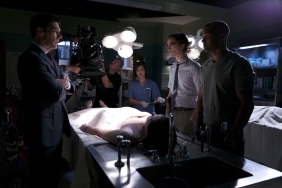 The technical analyst serves the team from the BAU’s home base at Quantico. The character
The technical analyst serves the team from the BAU’s home base at Quantico. The characterof Garcia joined the team after the FBI caught her hacking into their systems. Rarely does she
accompany the team to crime scenes; instead, she prefers to stay locked inside her computer lair
wearing bright eye shadows and lipsticks while frantically surfing the internet and databases for
information to assist the team.
How exactly does this help a writer? Through Garcia’s searches, we see exactly how an unsub’s
history plays a role in his or her present—where they lived, did they live in one place growing up
or did they move around a lot?; how they lived, did they hail from a happy home life, an abusive
home, or bounce from foster home to foster home?; as well as how those around them acted,
did they have a family member incarcerated or locked away with a mental illness? Garcia’s
digging through the digital life of an unsub directly relates to what a writer needs to do with their
antagonist.
Similarly, the PhD of the team also offers his genius to better understanding an unsub by way of
his eidetic memory. And I’m not throwing around the term “genius” lightly here; the character
of Reid is a literal genius—he graduated high school before he was a teenager; he has a Bachelor
of Arts in Psychology and Sociology; he has a PhD in Mathematics, Chemistry, and Engineering;
and he has an insanely high IQ. He reads faster than anyone on the planet (he scans the page
with his finger and remembers it verbatim), he remembers everything he sees, but he tends to
struggle with certain things that he hears. No one is perfect. Regardless, the amount information
stored in Reid’s brain spews out when studying an unsub.
How exactly does this help a writer? We see from Reid’s insane amount of knowledge that we
must first research our character’s quirks and tendencies prior to writing. If we don’t know the
how/what/when/where/and why behind why our antagonist is doing what he or she is doing,
we’re not doing our jobs as a writer.
Criminal Minds has everything we want and more in good television, especially for this fiction
writer, and it doubles as an excellent form of research into understanding a potential antagonist’s
actions in mysteries.
That’s my excuse for watching anyway…
Do you use television as a method of research for your writing? What other techniques do
you use? I’d love to hear from you!
I want to send out a big THANK YOU to PW for having me.
Look for my debut YA mystery novel, Football Sweetheart , coming soon… If anyone has any
questions or comments about my writing techniques or television, I’m always around for a chat
via Twitter and Facebook. And if you’re one of those people who don’t have more than an
hour or so a night for TV and you’re not quite sure where to begin, stop by my blog—let my
obsession help you!
Football Sweetheart http://tiffanyawhite.wordpress.com/football-sweetheart-a-ya-mystery/
Blog http://tiffanyawhite.wordpress.com/
Twitter https://twitter.com/#!/Tiffany_A_White
Facebook http://www.facebook.com/TiffanyAnneWhite
June 6, 2012
Intriguing Observations: Detective Techniques in Fiction Writing
novel…even those who write other genres. Below are a combination of investigative techniques
and skills that detectives may use to solve a case—or that writers might use to pen a novel.
May 30, 2012
INTRIGUING OBSERVATIONS: Fear and Critiques
The Intriguing Observations series was created to gather some of the greatest supporters and bloggers to provide their own insight on all things creative both in their ventures and their techniques. This week on the guest series is another all-star supporter and outstanding wordsmith, K.T. Crowley.
Even Seasoned Writers Fear the Red-Penned Reaper
You've built worlds, created characters to fill them and storylines to tie everything together. A personal, creative collection of words weaved into art for the imagination—all formed together into emotions, actions and consequences that took you on a roller coaster ride as you molded them. You're a writer. You love your story and (for most) hope to have it out there for the world to read someday, whether it be as a NYT bestseller or an eclectic indie author. The only problem is, you're afraid—but why?
Because what you love so much, others may not.
It's natural. No one likes judgment, especially judgment that may end in rejection. No one likes to hear that something they've poured their creative heart and soul in to and revised and edited tirelessly may not be up to snuff.
 When that fear strikes you, remember that writing is subjective, as with all forms of art. Not everyone is going to love your work. Even great writers like Stephen King have haters. But that doesn't mean you shouldn't push aside self-consciousness and put your work on the front lines. Sure, your best friend, sister, partner or co-worker tells you it's the next "Twilight" (should you have had the courage to ask them to read your work), but how subjective is their opinion? Would they really tell you what may not work in your writing by way of constructive criticism?
When that fear strikes you, remember that writing is subjective, as with all forms of art. Not everyone is going to love your work. Even great writers like Stephen King have haters. But that doesn't mean you shouldn't push aside self-consciousness and put your work on the front lines. Sure, your best friend, sister, partner or co-worker tells you it's the next "Twilight" (should you have had the courage to ask them to read your work), but how subjective is their opinion? Would they really tell you what may not work in your writing by way of constructive criticism?You owe it to yourself (and your hard work) to find out by entering the world of critiquing.
For those who don’t know, a critique is a detailed, subjective evaluation of your writing. It usually includes comments about plot, theme, dialogue, voice, characterization, contradictions, etc. Basically, they tell the writer (you) the things that don't work and holes that need to be patched.
Some critiques offer line editing, but the writer should be able to catch line editing issues before they do. Critiques give the writer the feedback and analysis they can't give themselves, exposing flaws in their writing, thus allowing them the information to perfect their work and give readers exactly what they need.
Even seasoned writers fear the red-penned reaper, but a critical part of the road to publication is learning to receive feedback. It may be tough to take, even scarring, but as long as those who are giving you the feedback are honest and respectful, constructive and courteous, it's a much needed step in giving your manuscript that glowing, polished shine it needs to succeed in the publishing world. Critiques should tear down your work (nicely) to help you build it back up properly.
 I'll never forget my first critiquing experience. I'd just decided to pursue publishing my first manuscript and didn't know much about critiques. Through an auction, I won a full manuscript critique from a seasoned writer who was completing work on her MFA at Vermont College of Fine Arts. With butterflies made of steel beating my already tender stomach, I sent my beloved manuscript to her. We corresponded via email for about a month while she went through it, and I started to relax—that is, until she asked to meet me in person to go over everything she'd commented on. To make a long story short, she loved my writing, my story, and was impressed by me, but that was said after an hour long chat, a 15 page summary of issues and hundreds of blood-red pen marks and comments on my once clean manuscript.
I'll never forget my first critiquing experience. I'd just decided to pursue publishing my first manuscript and didn't know much about critiques. Through an auction, I won a full manuscript critique from a seasoned writer who was completing work on her MFA at Vermont College of Fine Arts. With butterflies made of steel beating my already tender stomach, I sent my beloved manuscript to her. We corresponded via email for about a month while she went through it, and I started to relax—that is, until she asked to meet me in person to go over everything she'd commented on. To make a long story short, she loved my writing, my story, and was impressed by me, but that was said after an hour long chat, a 15 page summary of issues and hundreds of blood-red pen marks and comments on my once clean manuscript. Did the negative comments hurt? Of course. Did I consider throwing in the towel and giving up? Sure. But in the end, she wanted me to succeed as much as I did and provided me the cuts and bruises my manuscript (and I) needed to heal to make my writing stronger. It was an eye-opening experience, one I am forever grateful for. Do I still cringe when I receive a critique? Heck yes. But my writing is better for it.
It's why I now encourage other writers in our community to seek the same, through social networking and my own website (ktcrowley.com), by offering a safe venue to receive constructive feedback on samples of their writing.
There's a large amount of writers out there who say things to me like "I want to be published, but I don't think I can handle the critics" or "I'm not ready, my writing’s not ready". You'll never know what you're ready for until you take a chance. I was once there and believe me when I say there is no time like the present to thicken your skin and go for it, especially novice writers who can take the feedback and apply it to future work. Almost all issues uncovered through critiques can be fixed, but you have to be open to it.
Do not be subjugated by critiques of your work, though. After all, it's your baby. You can take what a critique gives you and work with it, or you can chose to ignore it. You are the creative mastermind and shall remain so. And to be honest, not every critique is going to hit the nail on the head. Some can be harsh, over-critical and downright mean (trust me I know from experience). Again, it’s all subjective. But if you get several critiques with the same types of comments, you shouldn't ignore those. That's part of what makes critiques so invaluable; they see the issues the writer can't.
I personally believe the best critiques come from other well-read writers of similar genres who offer their feedback in what I call a "Critique sandwich"; something good, then the bad, then finish off on a positive note. They should believe in your writing and want you to succeed just as much as you do. A critique partner should be professional, willing, qualified and knowledgeable enough, and you should be able to do the same in return (should you form a partnership). Also, not every critique partner is going to be a good fit. Like all relationships, you have to mesh well. It may take a little trial and error to find that in a person/group, but the benefits are worth the search. There are several places to seek out critiques/critique partners:
Agentquery.com has message boards dedicated to finding critique partners.
You can put it out there via your own blog, Facebook, Google+, Twitter, etc. that you are in search of a good critique partner.
Writing associations such as SCBWI have boards that offer a place to post work for critique.
You can join (or start) a writing group locally (a great place to look would be your local library).
Approach a fellow writer you've come to know and trust.
Hire someone (provided they have the experience and references to back up their service).
Even a Google search can provide you with different avenues to find one. And you're always welcome to stop by my blog and join in one of the monthly critique sessions offered.
So, what are you waiting for? You've got the talent and the drive, now it's time to go out there and get the critiques to make your amazing creation truly shine. Like with edits and revisions, your writing will thank you for it.
 K.T. Crowley is a YA writer, reader, lover of chocolate, bloggess, and most importantly, a mom. When she's not chasing after her toddler, listening to the characters in her head or typing away, you can find her in the shower, where she does her most important literary brainstorming. K.T. is a member of SCBWI, a 2011 NaNoWriMo winner, and is currently seeking representation. You can find her on Twitter @KTCrowley, on Facebook www.facebook.com/crowleykt or visit her website at www.ktcrowley.com
K.T. Crowley is a YA writer, reader, lover of chocolate, bloggess, and most importantly, a mom. When she's not chasing after her toddler, listening to the characters in her head or typing away, you can find her in the shower, where she does her most important literary brainstorming. K.T. is a member of SCBWI, a 2011 NaNoWriMo winner, and is currently seeking representation. You can find her on Twitter @KTCrowley, on Facebook www.facebook.com/crowleykt or visit her website at www.ktcrowley.com
May 20, 2012
Lost in Development
Platform, platform, platform.
As you're first diving into the writing world, you hear a lot about developing your writing for publication and developing your writing platform. There is a lot of discussion about what the first move is towards publication, do you join writing groups or develop your personal brand? While that is more of a personal argument, there is strength in establishing a primary platform after you have cover-art.
When you establish a writing platform, it's not only about creating a medium for your voice, it's about branding yourself and your work. This is where things can get interesting. Personal branding is not only about developing a tone for your work but a distinct style that is identifiable with you. This is the very definition of branding, distinctive style, iconic images and specific tag lines that convey everything that is the brand.
So, when I first launched my platform last year I hoped it would be effective and I had no idea if I would write anything anyone wanted to read or if it would be a representation of my style, my brand. Writing Files and now The Surveillance Report have been very effective both at establishing my voice and presenting my persona, my style and brand. While a blog is essential for any writer's platform, even more essential at challenging your writing skills, it is only a piece of a true platform.
If a blog is the core, the heart of any writer's platform, then the website would be the actual body.
A website presents a unified brand, there are continual updates, video, photo, and easy to use links that tie together all of the author's platform elements. This is where things can now become very confusing. In the past it was as simple as choosing to build a website to represent yourself, today a blog can carry all of the same functions. So, what are the advantages of a website over a blog? Is there even a distinction today? Many websites are actually built using blogging platforms, wordpress, blogger, etc.
As a designer that can also develop I found myself in quite a bit of a conundrum. I had to pull myself away from writing and editing the sequel to Nightfall just to develop a platform that suited my current needs and answer all of the fundamental requirements by readers. Jody and Roni have great insights here and here.
I started scrounging around looking for inspiration, what should an author site have? What are the essential elements, what do the best author sites have in common? Well, to my dismay as a designer, I was absolutely horrified by what I found. Not only do authors violate branding rules, but also every internet marketing premise when it comes to their websites. I could only find the Huffington Post's article on the top Author websites. It was very telling, even top named authors have atrociously bad websites. It's clear that some of these authors would never make it as fresh-blood today.
So, avoiding the mistakes and aiming for a very savvy site, I wasted an entire week building a website that still didn't turn out the way I had envisioned. It was all too easy to stop and call it done, but as a writer today either just starting out or a fresh-blood author platform and branding are just as integral as the writing that you produce. This first effort cost me two weeks and it was a complete waste of time. I did not want to waste my time any further and I certainly did not want to be another of the authors where you stumble across the site and say "Wow, when was THAT built?"
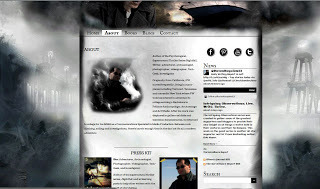 It was about this time I stumbled across an article by fellow wordsmith Roni Loren that discussed her new website and how she put it together with a new platform. So, I followed her advice and gave this platform called 'squarespace' a chance. I gave it a couple of hours and thought it was terrible, I couldn't get it to do anything I wanted. Then it clicked. After perusing the squarespace boards I could get the site to do anything I wanted it to with a few clicks.
It was about this time I stumbled across an article by fellow wordsmith Roni Loren that discussed her new website and how she put it together with a new platform. So, I followed her advice and gave this platform called 'squarespace' a chance. I gave it a couple of hours and thought it was terrible, I couldn't get it to do anything I wanted. Then it clicked. After perusing the squarespace boards I could get the site to do anything I wanted it to with a few clicks.
I devoted a couple hours to designing the site and with only a bit of fussing I had the entire site built and not one but two blogs constructed (including pulling in all of the Surveillance Report and comments). It was clean, modern and matches all of the needs. While it's not revolutionary in layout or styling, I love the look of it and it is me. It was completed in just a few short hours and now I'm back on track.
-Side note - Particularly proud of the design with the headers. -
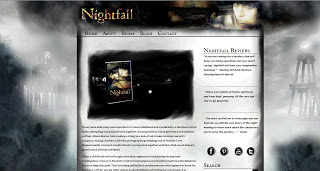 So what is the takeaway? Well, if you're a writer then you need something that defines and presents your brand but you also need something that won't hurt your writing time. Writers are some of the best individuals, and the last thing anyone wants is to hear laughter because of their heinously bad website. A website is the very structure of a writing platform it needs to be built well and it needs to cater to a host of needs including your blog.
So what is the takeaway? Well, if you're a writer then you need something that defines and presents your brand but you also need something that won't hurt your writing time. Writers are some of the best individuals, and the last thing anyone wants is to hear laughter because of their heinously bad website. A website is the very structure of a writing platform it needs to be built well and it needs to cater to a host of needs including your blog.
In short, writers have precious little time. While you might be able to build, design and orchestrate a platform from scratch, it doesn't mean that you should.

